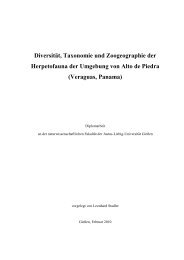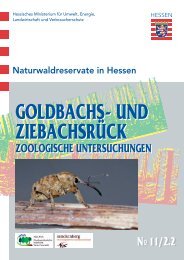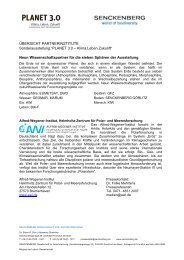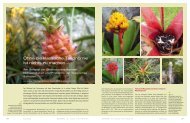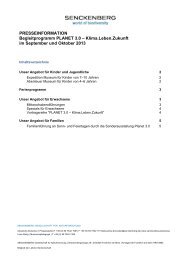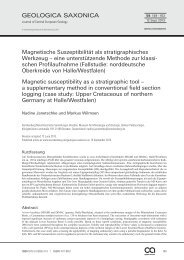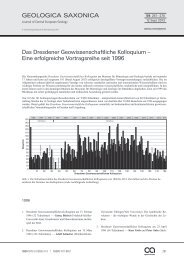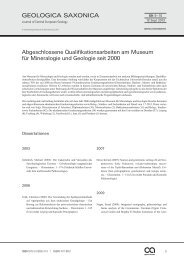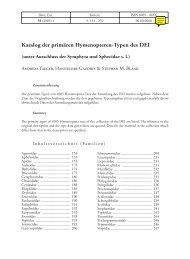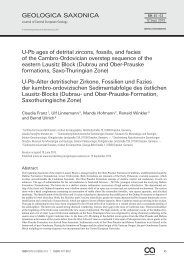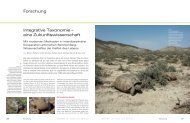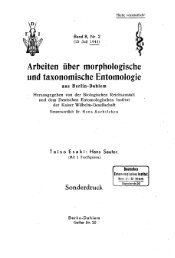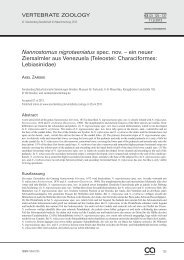Oribatid Mites (Acari: Oribatida) - Senckenberg
Oribatid Mites (Acari: Oribatida) - Senckenberg
Oribatid Mites (Acari: Oribatida) - Senckenberg
You also want an ePaper? Increase the reach of your titles
YUMPU automatically turns print PDFs into web optimized ePapers that Google loves.
88<br />
Gerd Weigmann<br />
Redescription<br />
General characters: Body length 415–500 µm; females 450–500 µm, mean length 472 µm<br />
(n = 10); males 415–480 µm, mean length 445 µm (n = 8). Body colour brown, cerotegument<br />
not obviously developed, notogastral cuticular surface more or less smooth in light<br />
microscopical aspect, with indistinct paving-stone pattern in SEM picture (see Fig. 4d).<br />
Prodorsum: Rostrum broad, flattened, with small dens laterally, slightly convex or<br />
undulating medially (Figs 1, 4a). Prodorsum laterad and anteriad of lamellae with lateral<br />
slopes, upper part below lamella looking like ridges (Fig. 4a). Rostral seta curved, strongly<br />
barbed, inserted at base of tutorium, extending near tip of rostrum. Cusp of lamella narrow,<br />
about 18 µm long; distance between cusps (translamellar length) about 30 µm; translamella<br />
well developed, about 8 mm wide (Fig. 1). Lamellar seta long (65–80 µm), barbed,<br />
acuminate, extending beyond tip of rostrum. Interlamellar seta in strong, barbed, acuminate,<br />
about 100 µm long, inserted under anterior notogastral tectum. Seta ex about 8 µm length,<br />
inserted on small tubercle. Sensillus short claviform, flattened dorsoventrally (i. e. broader in<br />
dorsal than in lateral aspect; confer Figs 1, 2, 4c), head slightly spiculated; bothridium<br />
covered by anterior edge and tectum of notogaster. Between alveoli of setae in present small<br />
transversal ridge. Tutorium broad, variable with broadly rounded to triangular free tip, with<br />
two to six small dens (Figs 2, 4b). Genal tooth broad, acute. Pedotectum I distally very broad,<br />
with concave dorsal margin (Fig. 2).<br />
Notogaster: Typical shape of notogaster, anterior tectum convex; anterior edge of<br />
notogaster with thin ridge. Pteromorphs with line of desclerotisation. Ten pairs of fine<br />
notogastral setae 15–25 µm long. Octotaxic system with slight sexual dimorphism: Four pairs<br />
of areae porosae oval in females, among them A1 largest (Fig. 1); in males area porosa Aa<br />
enlarged with irregular longish shape, A2 and A3 longish oval (Figs. 3, 4d). Posterior<br />
notogastral tectum with overlapping lobes (Fig. 3c).<br />
Gnathosoma: Subcapitulum diarthric, as typical; no specific characters observed.<br />
Ventral region: Structures as normal for the genus (cf. Fig. 7). Discidium with acute<br />
custodium. All ventral setae small and smooth, anal and adanal setae moderately longer;<br />
Postanal porose area (A.p.a. in Fig. 3c) a narrow transversal ribbon in both sexes (visible in<br />
caudal view).<br />
Legs: All legs heterotridactylous; femora I and II with 4 setae, genua I and II with 3 setae.<br />
Distribution and ecology: The species occurs in the Atlantic coastal regions of Europe<br />
from Denmark to South Portugal: Ireland (Halbert 1920); South England (Luxton 1967a,<br />
1967b); Germany (Willmann 1937, 1952, Strenzke 1952, Knülle 1957, Weigmann 1973,<br />
Koehler et al. 2008); Denmark (Weigmann 1973, Polderman 1974b); The Netherlands<br />
(Polderman 1974a); Portugal (several records from the North to the South; this work).<br />
Published records of this species from Alaska (cit. in Marshall et al. 1987) were<br />
misidentifications (Behan-Pelletier pers. comm.), and represented Z. maritimus Shaldybina<br />
(Behan-Pelletier 1988). Published records from Canada (cit. in Marshall et al. 1987) may also<br />
represent this species, but specimens are not available in the Canadian National Collection to<br />
corroborate this. Zachvatkinibates quadrivertex was not referred in Behan-Pelletier & Eamer<br />
(2005).



